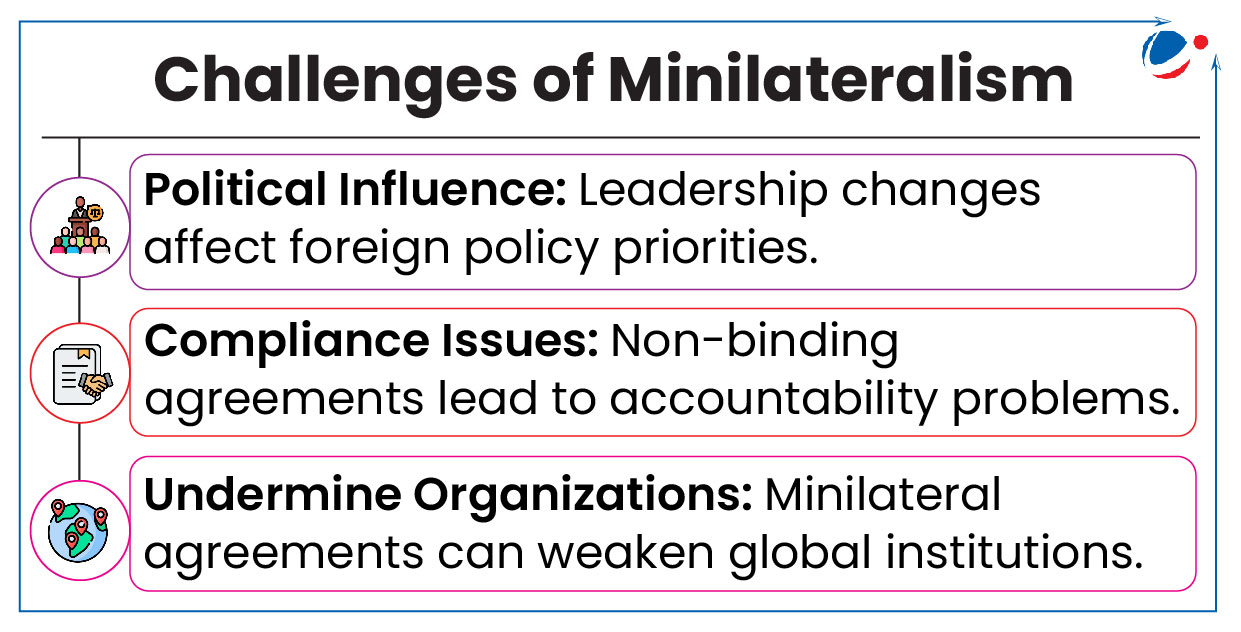Why in the news?
Recent adoption of Cybercrime Treaty by UN General Assembly is not only a breakthrough for a fractured cyber governance system but also a major victory for multilateralism.
UN Cybercrime treaty and resurgence of Multilateralism
- In recent times, a number of factors like the rise of nationalism, populism, economic inequalities, great power competition is leading to the fall of liberal world order and multilateralism.
- Also, there has been a growing access to internet, rising cybercrime, inadequacy of liberal institutions, broken international dialogue all of which has caused erosion of multilateralism.
- The above factors have led to the emergence of short-term strategic alliances and minilaterals, involving small groups of nations collaborating to pursue mutual goals.
- The process of adoption of UN Cybercrime Treaty, despite diverging national interests, is therefore a major triumph for multilateralism.
- The UN Cybercrime Treaty relied heavily on collective efforts to tackle the global and interconnected nature of cybercrime.
About Multilateralism and Minilateralism
- Multilateralism: It is defined as opposite to bilateralism and unilateralism involving cooperation between 3 or more states adhering to a common issue based on shared system of norms and values.
- Emergence: Most of the multilateral institutions emerged after the World War II. E.g., United Nations, International Monetary Fund, World Bank, General Agreement on Tariffs and Trade (GATT), NATO, etc.
- Minilateralism: It is an informal, flexible, and voluntary framework with varied situational interests, shared values or relevant capabilities. It allows nations to collaborate on critical issues without holding the same worldview.
- Emergence: It is not a new idea and coexisted in global governance since 1945.
- It was pursued in disguise between major powers and led to the creation of multilateral institutions.
- E.g., GATT originated as minilateral negotiations between major powers, and was subsequently multilateralised by adding other countries.
- Emergence: It is not a new idea and coexisted in global governance since 1945.
Comparison between Minilateralism and Multilateralism
Parameters | Minilateralism | Multilateralism |
Actors Involved |
|
|
Formality |
|
|
Target |
|
|
Level of Engagement |
|
|
Example |
|
|
Factors Responsible for the shift towards Minilateralism
- Rising multipolarity: Emergence of multiple centres of power like the rise of China, Russia has challenged the multilateral institutions established under USA's leadership.

- Strategic Alliance Vs Global Cooperation: Strategic alliances facilitate creation of issue-specific partnership with like minded countries.
- E.g., QUAD, India-Japan-USA trilateral, etc. foster greater defence and security cooperation in the new regional theatres like Indo-Pacific.
- Easy Regulation: Informal mechanisms used in minilateral institutions such as the Basel Committee and the Financial Stability Board offer advantages like the bottom up approach, flexibility, in regulation, etc.
- Decision Making: Large organisations having formal institutional structure, international bureaucracies, and heterogenous membership often delays decision making.
- Agile and adaptable approach of minilateralism helped in the quick culmination of "Partnership for the Future" to I2U2 (India, Israel, UAE, USA).
- Stagnation in reforms: The membership of United Nations Security Council does not depict the present realities, stalemate in WTO Doha rounds, etc.
- Perceived failure of Multilateralism: To achieve global cooperation on the most pertinent issues faced by the international community.
- Recent CoP-29 of the UNFCCC highlighted the issue of climate finance and climate justice.
Need for co-existence of Minilateralism and Mulitlateralism
- Minilateralism as building blocks of Multilateralism: It could supplement the inadequacies of existing multilateralism without delegitimizing it.
- E.g., strength of minilateralism lies in its ability to achieve concrete results timely, hence it could act as a catalyst for operationalization of multilateral-level dialogue.
- Streamlining Negotiations: Minilateral lay the groundwork for political dialogue and promote confidence-building between key partners, before being taken up at the multilateral platforms.
- Regional groups like European Union (EU) and Association of Southeast Asian Nations (ASEAN), etc., can arrive at informal consensus with high possibility of formal consensus.
- Accelerate the pace in multilateral negotiations: E.g., Paris negotiations of 2015 received an impetus with the finalisation of US- China agreement (major emitters) on reducing emissions.
- Filling gaps: Multilateral institutions suffer from issues like pending reforms, while minilateral institutions can suffer from power imbalance and may lead to several conflicting agreements.
- Synergy between the two can help overcome the above challenges.
- Dealing with Global Challenges: Like climate change, terrorism, etc., require enhanced forms of co-operation at regional and global scale.
- Rule-Based Framework: Multilateral organisations help build consensus towards legally binding treaties like UN Convention on the Law of the Sea, offering a rules-based framework for minilateral cooperation.
Conclusion
While minilaterals cannot replace multilaterals, they can supplement the work of multilateral organisations by providing a platform for diplomacy, confidence-building, and cooperation. Example, in case of climate action, minilaterals can provide an inclusive platform for interacting with sub-national and non-government actors to formulate innovative solutions for global warming.



